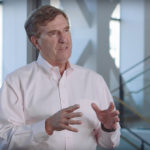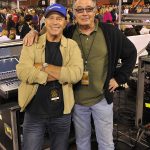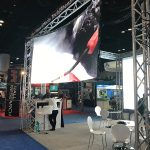Theatre lighting designer. Concert lighting designer. Television lighting designer. Professor. Lecturer. Author.
Jim Moody has many vocations, but despite an amazing career so far, producing a head-spinning list of great rock acts he’s worked with, there’s one role that he puts above all those: Mentor.
“I’m a big believer in mentoring,” he states emphatically. “I tell all my students that finding a mentor is important.” Moody himself still has a mentor in GAM Products founder and president Joe Tawil, and both Moody and Tawil continue to mentor scores of prolific professionals in the field.
“Jim is a terrific designer, and he’s done it all,” says long-time lighting designer and friend Jeff Ravitz. “He’s done theatre, television, events, and spectaculars. He’s also been an equipment vendor and business owner. He understands design from the inside out, and his instincts are sharp and creative.”
“Study Lighting”
Moody was born in Joliet, IL. In high school, he sang in choirs and performed in musicals before putting all that silliness behind him to major in advertising at Bradley University in Peoria. Yet by Christmas of his freshman year, he knew he was in the wrong place, so he dropped out and signed up for a stint in the Air Force. The year was 1960. “My grandmother and mother cried when I told them, and my step-father said, ‘Atta Boy!’” he laughs. He would be assigned the intense, pressure-cooker position as an air traffic controller where, “if you crashed two planes together, you’d go to jail for life.”
Once out, he went to Southern Illinois University in Carbondale to study English, but got distracted by theater. A visiting professor, Sam Selden, decreed that Moody would be good at it. “Study lighting,” he advised.
Moody was far from a starry-eyed youth at this point — he was an older college student who had just recently married, and so demurred the compliment. But Selden wouldn’t let go: “What if I could you get into the UCLA Master’s program on my word alone?”
Moody pointed out that he had never lit anything in his life. “To the day he died, he never told me why he said that.
“What could I do?” Moody adds.
Off to UCLA to study lighting he went, and there he met Willy Crocken, who was the school’s technical director at the time. When he graduated in 1969, Moody was offered the enticing TD position at Valencia, CA-based California Institute of the Arts (CalArts), but Crocken advised against it. Crocken would steer him to a job at Berkey Colortran working for Joe Tawil.
For the next several years, Moody lived large: playing with the “toys” the lighting manufacturing company produced by day, and lighting shows at night, which Tawil supported. He laughs and says the best-of-both worlds scenario allowed him to practice his craft and “avoid the usual hump of lighting dance for no money just to get a career started.”
A Simpler Time
Thinking about those early days, when true concert production was getting more professional, he states that “it was a simpler time —there wasn’t as much competition!” Not necessarily by design, but five lighting giants emerged in the early 1970s coinciding with the growth of big concert tours, and Moody, Bob See, Bill McManus, Tom Fields, and Chip Monck worked their respective regions of the country.
Moody took a different career trajectory. Rather than doing a lot of concert touring, he let the tours come to him. He got himself hired as the lighting designer for Hollywood’s Palladium, covering rotating concerts of the biggest acts of the time including Joe Cocker, Rod Stewart, ABBA, Grateful Dead and many more.
But it was a very different time from today. “I dealt with union followspot guys who hated the smell of ganja. I’d go backstage and ask the band for a set list and get a, ‘Yeah, we used to have one of those…’”
Not content to wing it, he’d listen to the albums of the band he was about to light, get a feel for tempo changes and where solos were placed, and rely on his own experience performing in high school to run the show. There was one other skill that came to be surprisingly useful during this formative period: his years in the military working the air traffic control tower. “I didn’t get flustered. It was key, frankly, to my success.”
He did hit the road occasionally, often with the proprietors of the Southern California rock sound: Linda Ronstadt, Eagles, and Jackson Browne. Then he was in Las Vegas working with the Osmond family, where he picked up on their television-trained talents. This would come in handy for his next big move.
Live TV
How could Moody imagine that what would happen next would be not just another call for a television gig, but would get him involved in yet another important aspect of rock ‘n’ roll history?
On September 27, 1973, the lights came up on TV’s Don Kirshner’s Rock Concert, and Moody was behind the board. Unusual at the time, the show had bands play live as opposed lip-synching. “I worked with virtually every band there was for seven years,” he says. “It was an especially investigative period. I wish the lighting books I’d write later were around then!” Instead, he leaned on his mentor and the increasingly tight band of brothers including See, Fields, McManus and Monck — and take their calls too when they had questions about whatever they had.
Equipment was scarce, and many of these pioneers built their own gear. Moody built a lighting board that was later produced by a manufacturer in England. Building dimmer racks that worked for rock ‘n’ roll was the norm, and the lack of standardized cables needed for a gig kept Moody and other pioneers busy.
Embracing Technology
Throughout his career, Moody has always been quick to embrace technology. When computers started to come into play, he latched onto them and ignored the disdain he got from other LDs. “I’d get ragged on about how a lighting show needs [to be organic], needs to be created on the spot every night, and I’d say, ‘Bull—-! It’s about giving the artist the same thing every night!”
Just as his experience as an air traffic controller would help his career, so did his English studies. Tawil would encourage him to write and, after a few well-received articles, he penned Concert Lighting in 1989. (The third edition, Concert Lighting: Techniques, Art, and Business, can be found at plsnbookshelf.com).
“I’ve learned so much from Jim over the year,” says Ravitz. “His strong suit is knowing how to keep it simple so the design doesn’t get in its own way. Whenever I find myself overcomplicating a design or cue, I channel Jim’s design brainwaves and get myself back on track.”
Today, Moody is teaching full time and head of design at Los Angeles City College, lecturing, writing, and, of course, lighting. “I’m still lighting about 12 theater shows a year,” he says. It’s an interesting career that seems to have boomeranged: Plenty of theater lighting designers have made their way into concert lighting (especially in the early days of the industry), or even gone through TV and film; but Moody has ended up back in theater. He laughs when this is brought up, saying, “I’ve always gone in the opposite direction of where I saw everybody else going!”
Despite his years of experience, his approach to theater lighting could not be more basic: “I’m a big believer that it’s the director’s show,” he says. “So if he or she has a vision, I’m going to try to create that vision for them.”
Toggling back and forth between concert and theater is a science. “One of the things about rock is you don’t have a director. The band thinks they are, but they aren’t, really. And there are exceptions: Willie Williams gets in the car every night and replays the show on video with Bono. And there’s my good friend Jeff Ravitz with Bruce Springsteen … but mostly it’s the designer, and you’re being guided by the music and trying to match it and build on that.”
He returns the conversation to mentoring. “Joe was that person for me, and I’ve done it for many others. I started a mentoring program at USITT — we had a famous lighting designer sitting there, and I overheard some kids stop and say, ‘Isn’t that so-and-so?’ followed by, ‘Oh, we couldn’t bother him.’ I thought, ‘I bet he’d love you kids to ask him something.’
“It’s important to have someone encourage a younger lighting designer and have someone to call to ask a specific questions … or just talk to. I still take those calls myself.”


